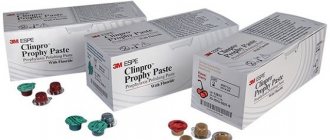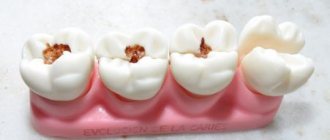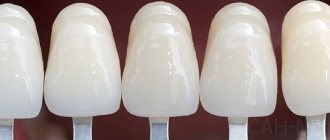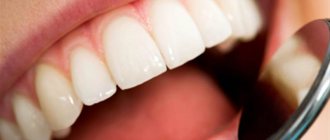Pathologies of hard dental tissues are not always the result of caries and other inflammatory processes. A wedge-shaped tooth defect only superficially resembles an old carious lesion. The mechanism of development of this pathology is different and not fully understood.
With a wedge-shaped defect, the enamel is deformed at the place where the dental crown adjoins the gum. At first it is a rough, matte hole, then the planes of the lesion close together and are shaped like a wedge (the letter V).
Why a wedge-shaped tooth defect develops is still unknown. There are several theories and they all consider excessive stress on tooth enamel.
Why wedges form on teeth and what to do about it
The defect can develop on both the upper and lower jaw, on one or more teeth. Most often, canines and premolars are affected - namely, they experience a large chewing load. The disease develops gradually and unnoticed. Over time, the defect deepens into the dentin, and the person feels pain. If the problem continues to be ignored, the base of the tooth becomes so thin that it can break.
A wedge-shaped defect appears in people of different ages, including teenagers. However, the older the person, the greater the risk of developing pathology.
The moment of appearance of the wedge-shaped defect cannot be tracked independently. But if you undergo regular examinations with a dentist, treatment will begin on time and will be completed with minimal time and money.
At first glance, a wedge-shaped defect can be confused with cervical caries. The affected teeth are marked with triangular-shaped spots and depressions, up to 4 mm in depth in the acute stage of development.
As for where wedges on teeth come from, there are three generally accepted theories:
- Chemical. The culprit is aggressive acids from food, drinks and resulting from an imbalance in the acid balance of the oral cavity.
- Mechanical. The defect is caused by an external load.
- Physico-mechanical. Pathology develops in response to improper chewing load.
What should I do if I have a similar but different question?
Medical portal 03online.com
provides medical consultations via correspondence with doctors on the website. Here you get answers from real practitioners in your field. At the moment, on the site you can get a consultation in 45 areas: an allergist, venereologist, gastroenterologist, hematologist, genetics, gynecologist, homeopath, dermatologist, children's gynecologist, children's neurologist, children's surgeon, children's endocrinologist, nutritionist, immunologist, cardiologist, cardiologist, cosmetologist, cosmetologist, cosmetologist speech therapist, ENT specialist, mammologist, medical lawyer, narcologist, neurologist, neurosurgeon, nephrologist, oncologist, urologist, orthopedist-traumatologist, ophthalmologist, pediatrician, plastic surgeon, proctologist, psychiatrist, psychologist, pulmonologist, rheumatologist, sexologist-andrologist , dentist, urologist, pharmacist, herbalist, phlebologist, surgeon, endocrinologist.
We answer 95.38% of questions.
Reasons for the development of pathology
There are many reasons for the appearance of a wedge-shaped defect. Among them
- Aggressive tooth brushing. We are talking about excessive pressure on the teeth, chaotic movement of the toothbrush. For daily care, the brush should be directed from top to bottom using soft scrubbing or circular movements. If you rub your teeth horizontally, you injure the enamel. Do not use brushes with hard bristles.
- Exposure to acids that come from food. Their suppliers are citrus juices and soda. Acid disrupts the natural protection of teeth and the enamel wears off faster when brushing your teeth or chewing food.
- Malocclusion. In this case, the load between the teeth is distributed incorrectly and additional pressure falls on the area of the transition of the crown to the root of the teeth. Additional risk factors are bruxism (teeth grinding), dystonia of the masticatory muscles, and dental defects.
- Frequent teeth whitening. Enamel is destroyed not only by uncontrolled home bleaching with lemon juice, soda and improvised abrasive substances, but by professional procedures if carried out more often than 1-2 times a year. To avoid becoming the owner of tooth enamel wearing away in the cervical area, replace frequent whitening with remineralization and fluoridation. Whitening pastes should also not be used constantly. They work great in courses lasting no more than 30 days, 1-2 times a year.
- Gastrointestinal diseases and hormonal imbalance. Increased stomach acidity can weaken the enamel and lead to the formation of a wedge-shaped defect. Women over 40 years of age are also at risk - hormonal changes lead to calcium leaching.
- Gum diseases. With periodontitis and periodontal disease, the necks of the teeth are exposed and their thin enamel is destroyed by acids and plaque bacteria.
- Alcohol abuse and smoking. Alcoholic drinks and tobacco smoke are aggressive to the microflora of the mouth. This leads to demineralization and tooth decay.
- Frequent consumption of solid foods.
- Incorrect treatment by an orthodontist.
- Heredity.
- Chemotherapy in the treatment of cancer.
What to do
It is very important to discover the cause of such a symptom. Only an experienced specialist, after a preliminary examination, can prescribe therapy
In case of poisoning or infectious processes, antibacterial drugs, antipyretics, and sorbents are prescribed.
To treat gastritis, diet, antispastic drugs, antibacterial agents, antispasmodics, enzymes, and mineral waters are used. The plaque that appears after eating foods with bright pigments goes away on its own after a day. Normally, the film should be cleaned using a scraper or toothbrush. If the plaque does not disappear, it is recommended to consult a doctor.
Stages of development of a wedge-shaped defect
The wedge-shaped defect develops gradually. The following stages of process development can be distinguished:
- First changes in enamel. A small area at the base of the tooth darkens slightly and loses its shine. Over time, it will develop pigmentation. At this stage, the future defect can only be seen using a special device.
- Superficial lesion. At the base of the tooth there is a noticeable crack, at its widest part not exceeding 3.5 mm. The gums sag, the neck of the tooth is exposed. The patient is uncomfortable with food that is too hot or cold, but the pain quickly goes away.
- Progressive stage. The wedge-shaped defect deepens to 4 mm, becomes yellowish-brown, matte. The shape of the triangle is already clearly visible - the two affected planes of the tooth converge at an angle of 45 degrees. Teeth react painfully to temperature stimuli and acidic foods. It is painful for the patient to brush his teeth. He feels the defect as a kind of step at the base of the tooth, where the remains of soft food are retained. At this stage, the diseased tooth is already noticeable to others when smiling and talking.
- Launched form. The enamel becomes thinner, dentin is affected, and in difficult cases, even the pulp. The wedge deepens to 0.5 cm, the neck of the tooth is exposed. If the destruction reaches the pulp, the neurovascular bundle of the tooth becomes inflamed. Acute paroxysmal pain appears, the tooth reacts to the temperature and taste of food, touch, the chewing process and causes a lot of inconvenience.
Video of teeth cleaning with AirFlow system
Notice
: Undefined variable: post_id in
/home/c/ch75405/public_html/wp-content/themes/UltraSmile/single-item.php
on line
45 Notice
: Undefined variable: full in
/home/c/ch75405/public_html/wp-content /themes/UltraSmile/single-item.php
on line
46
Rate this article:
plaque
Diagnostics
A wedge-shaped tooth defect is usually identified by a dentist during a routine examination or treatment. He evaluates the location and shape of the pathology, the density of the tooth tissue. It is important to confirm that we are not dealing with dental erosion, superficial, cervical caries or enamel necrosis.
The doctor examines the patient’s dental status (oral hygiene, number of caries-affected, filled and extracted teeth, gum condition) and conducts a thermal test. This is a tooth reaction to temperature stimuli.
Vital staining helps in establishing the diagnosis: the wedge-shaped defect is well stained with iodine solution, but retains its color when treated with methylene blue. It is also important to determine what malocclusion pathologies exist and how they affect the occurrence of the pathology.
To exclude the influence of somatic diseases, the doctor may refer the patient to an endocrinologist and gastroenterologist.
It doesn't hurt at all!
When some hard-to-reach cavities are too tough for this technology, other equally effective methods are used. During chemical-mechanical treatment of a tooth, a gel containing special enzymes and having disinfectant properties is applied to the damaged surface. They literally “dissolve” carious tissue, which is removed along with the gel with a special spoon. The gel is colorless and odorless, does not irritate the mucous membrane, and small patients tolerate this treatment easily. Almost any intervention in the dental cavity can now be carried out with 100% pain relief
But it is very important for the baby’s nervous system if he does not see (let alone feel) the needle at all. Then a soothing mixture of nitrogen and oxygen will be prepared for the baby, which he will breathe through a funny bright mask. The sweet, pleasant aroma will help him feel calm and relaxed.
This technology is safe for children of any age. There is no addiction to the mixture; it is easily removed from the body.
Treatment
When treating a wedge-shaped tooth defect, the doctor first restores its integrity, then prevents its further destruction. If necessary, dentists of narrow specializations are involved in the treatment of a wedge-shaped defect: therapists, orthodontists, orthopedists.
The following will help restore the condition of the tooth:
- Installation of seals. The doctor removes the altered tissues in the cervical area, and installs filling material in their place. When restoring medium and complex defects, the doctor uses a light-curing fluid composite and compomer materials. They are quite elastic and can partially compensate for the load on the teeth. The best fillings are installed using the sandwich technique: the bottom layer is made of dental cement, the top layer is made of composite materials. For better aesthetics, your doctor may suggest installing ceramic veneers.
- Fluoridation and remineralization. The procedures restore the mineral content in the enamel, this heals the tooth and slows down the process of destruction;
- Prosthetics. If the tooth is severely damaged and there is a risk of fracture at the base of the crown, the doctor will be forced to install a denture. Usually this is permanent prosthetics made of metal-ceramics or using ceramic crowns.
If the wedge-shaped defect has just begun to develop, the following will help slow down the process:
- Remineralizing therapy. Applications with calcium and sodium preparations are applied to the affected part, and the patient is recommended to take a course of vitamin-containing complexes. Remineralization courses must be repeated regularly and they only help at the initial stage of the disease;
- Fluoridation. Effective in cases of deep damage to the enamel, applications with fluoride preparations seal the tubules of the tooth tissue and reduce its sensitivity;
- Laser therapy. Reduces tooth sensitivity and inhibits the development of the disease. Laser treatment is recommended for pregnant and lactating women and patients with allergies.
For home care, the doctor will recommend pastes and gels enriched with a special mineral composition.
Content:
- Tooth enamel: general characteristics and properties:
- Possible reasons:
- What to do if your child’s baby teeth are brown.
1.1. Maturation of enamel.
2.1. Plaque. 2.2. Enamel hypoplasia. 2.3. Fluorosis. 2.4. Caries. 2.5. Other reasons.
Regardless of its cause, such a problem is a mandatory indication for comprehensive diagnostics. Moreover, we are talking not only about visiting the dentist, but also about consulting a pediatrician and highly specialized specialists, since brown plaque on children’s baby teeth can be the result of either a banal lack of hygiene or any diseases.
How to prevent the development of a defect
If the wedge-shaped defect is not treated, the disease will develop and the tooth will collapse. But treatment methods have their drawbacks, they are not durable enough and do not guarantee that the pathology will not invade neighboring teeth.
To avoid an unpleasant disease, you need to take into account risk factors and take care of your own health and dental condition.
The most important preventive measures:
- brush your teeth correctly and choose oral hygiene products;
- undergo regular examinations in good dental clinics;
- trust dental manipulations only to a trusted orthodontist;
- correct the bite in time;
- promptly treat periodontal diseases;
- exclude soda and sour juices. Eat fresh foods containing enough vitamins and minerals;
- promptly identify and treat diseases of the gastrointestinal tract, nervous and endocrine systems.
Priestley's Raid
Having noticed that the child’s front tooth has darkened, parents take a closer look at other units and may find that dark plaque covers the entire dentition in the area adjacent to the gingival margin.
This is what Priestley's plaque looks like - a bacterial film formed due to dysbacteriosis in combination with lack of dental care. The film stains and becomes darker over time. It is not possible to remove thick plaque on your own, but the dentists at the Shifa clinic have all the necessary equipment to use painless techniques to rid the child’s teeth of staining.
In this case, it would not hurt to consult a gastroenterologist and endocrinologist for early detection of systemic general pathology.










